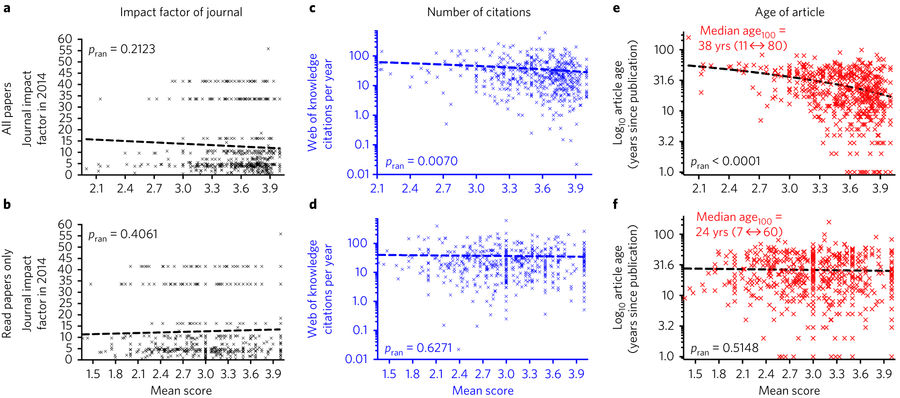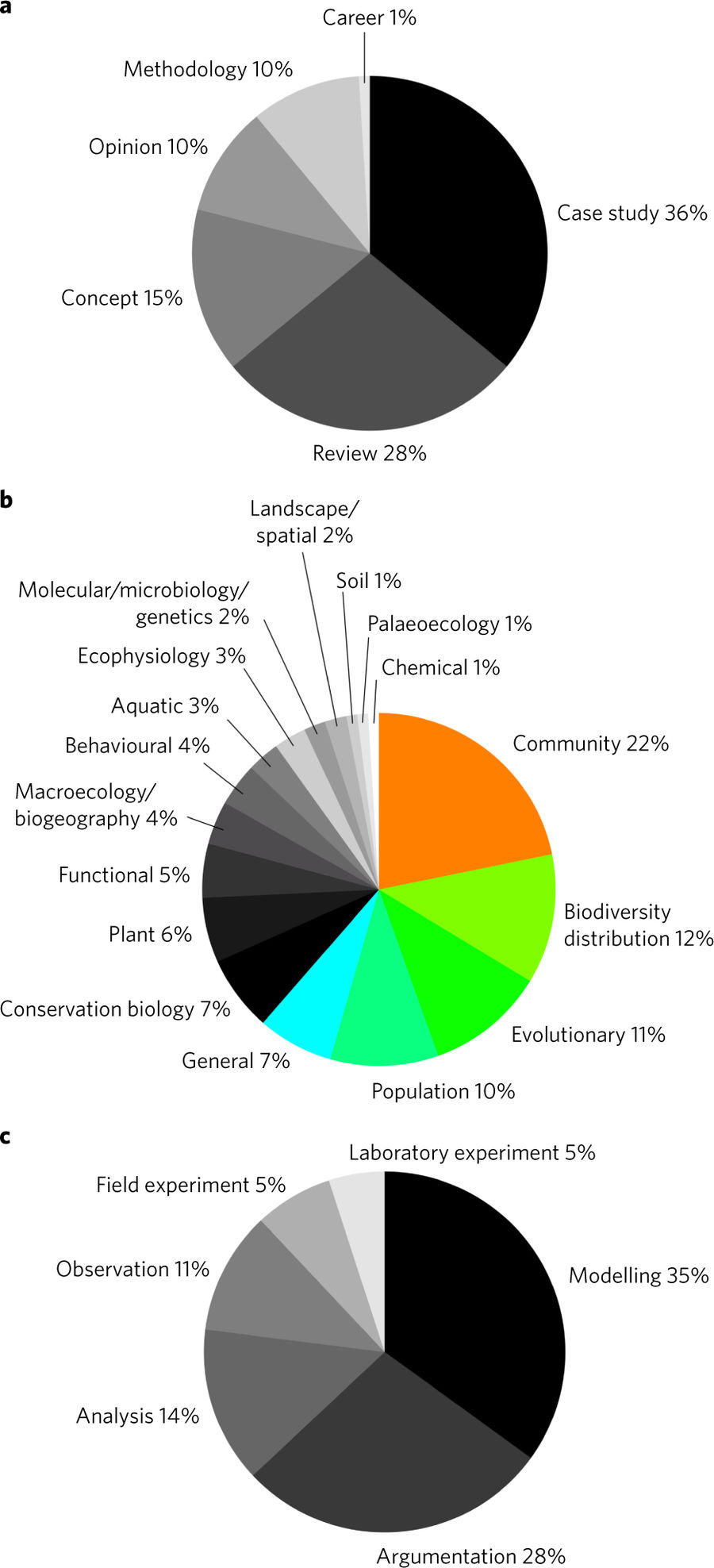100篇生态学论文
生态学博士生“必读”的100篇文献
欢迎点击「科学网」↑关注我们!
之所以加上引号,是因为,作者推荐的100篇文献较为陈旧,且较少,根本无法代表博大精深之生态学全貌。不过,在近期Nature Ecology & Evolution的这篇分析性文章中(研究论文“100 articles every PhD student should read”,链接:https://www.nature.com/articles/s41559-017-0370-9?WT.mc_id=COM_NEcoEvo_1711_Courchamp),作者列出的100篇他们认为“必读”的文献有一定的参考价值,我大致浏览了一下,涵盖了生态学的不少方面,有理论分析的,有模型研究的和概念性的论文。
重要的是,被推荐论文的作者基本上都是生态学领域的“大牛”(神一样存在的人物),如Connell,Janzen,MacArthur,Tilman和Odum等,这些响当当的名字如雷贯耳。
作者也承认他们推荐的“必读”论文不是一成不变的、更不是最终版,我个人也觉得,推荐的100篇论文过于“陈旧”(或许也说明较为“经典”?),快速发展中的生态学近几年也“蹦出”不少经典之作,如关于物候的、生态记忆的和节律的,以及土壤和植物生理生态的研究。
总之,作者Franck Courchamp & Corey J. A. Bradshaw也还是费力不少心思在揣摩推荐列表的。在他们的分析中,有一点很有意思,论文被推荐的程度与所发表的期刊、以及引用次数关系不大,说明了原创性的、开拓性研究工作才是最值得尊重的。下面我将列出作者推荐的100篇生态学论文,希望与大家共勉(有不少我没有读过!)。
Box 1: Box 1 | The 100 selected articles
An asterisk indicates articles that were proposed more than ten times before the vote.

1. Darwin, C. R. & Wallace, A. R. On the tendency of species to form varieties; and on the perpetuation of varieties and species by natural means of selection. Zool. J. Linn. Soc. 3, 45–62 (1858).
2. Hardin, G. The competitive exclusion principle. Science 131, 1292–1297 (1960).
3*. Paine, R. T. Food web complexity and species diversity. Am. Nat. 100, 65–75 (1966).
4. Hutchinson, G. E. The paradox of the plankton. Am. Nat. 95, 137–145 (1961).
5*. Hutchinson, G. E. Homage to Santa Rosalia or Why are there so many kinds of animals? Am. Nat. 93, 145–159 (1959).
6*. MacArthur, R. H. & Wilson, E. O. An equilibrium theory of insular zoogeography. Evolution 17, 373–387 (1963).
7. Hutchinson, G. E. Concluding remarks. Cold Spring Harb. Symp. Quant. Biol. 22, 415–427 (1957).
8*. Hairston, N. G., Smith, F. & Slobodkin, L. Community structure, population control, and competition. Am. Nat. 94, 421–425 (1960).
9. Connell, J. H. Diversity in tropical rain forests and coral reefs. Science 199, 1302–1310 (1978).
10. Janzen, D. H. Herbivores and the number of tree species in tropical forests. Am. Nat. 104, 501–528 (1970).
11. May, R. M. Biological populations with non-overlapping generations: stable points, stable cycles, and chaos. Science 186, 645–647 (1974).
12. Gause, G. F. Experimental analysis of Vito Volterra’s mathematical theory of the struggle for existence. Science 79,16–17 (1934).

13*. Chesson, P. Mechanisms of maintenance of species diversity. Annu. Rev. Ecol. Syst. 31, 343–366 (2000).
14. Carpenter, S. R., Kitchell, J. F. & Hodgson, J. R. Cascading trophic interactions and lake productivity. BioScience 35, 634–639 (1985).
15*. Levin, S. A. The problem of pattern and scale in ecology: the Robert H. MacArthur Award lecture. Ecology 73,1943–1967 (1992).
16. Hanski, I. Metapopulation dynamics. Nature 396, 41–49 (1998).
17. MacArthur, R. & Levins, R. The limiting similarity, convergence, and divergence of coexisting species. Am. Nat. 101, 377–385 (1967).
18. Tilman, D. Resource competition between plankton algae: an experimental and theoretical approach. Ecology 58, 338–348 (1977).
19. Hamilton, W. D. The genetical evolution of social behaviour. I. J. Theor. Biol. 7, 1–16 (1964).
20. Charnov, E. L. Optimal foraging, the marginal value theorem. Theor. Popul. Biol. 9, 129–136 (1976).
21. Tilman, D. Biodiversity: population versus ecosystem stability. Ecology 77, 350–363 (1996).
22. Rosenzweig, M. Paradox of enrichment: destabilization of exploitation ecosystems in ecological time. Science 171, 385–387 (1971).
23. Connell, J. H. The influence of interspecific competition and other factors on the distribution of the barnacle Chthamalus stellatus. Ecology 42, 710–743 (1961).
24. MacArthur, R. & Levins, R. Competition, habitat selection, and character displacement in a patchy environment. Proc. Natl Acad. Sci. USA 51, 1207–1210 (1964).
25. Hardin, G. J. The tragedy of the commons. Science 162, 1243–1248 (1968).

26. Levin, S. A. & Paine, R. T. Disturbance, patch formation, and community structure. Proc. Natl Acad. Sci. USA 71, 2744–2747 (1974).
27. Felsenstein, J. Skepticism towards Santa Rosalia, or Why are there so few kinds of animals? Evolution 35, 124–138(1981).
28. Tilman, D. Competition and biodiversity in spatially structured habitats. Ecology 75, 2–16 (1994).
29. Holling, C. S. Resilience and stability of ecological systems. Annu. Rev. Ecol. Syst. 4, 1–23 (1973).
30*. Hurlbert, S. H. Pseudoreplication and the design of ecological field experiments. Ecol. Monogr. 54, 187–211 (1984).
31. Vitousek, P. M., Mooney, H. A., Lubchenco, J. & Melillo, J. M. Human domination of Earth’s ecosystems. Science 277, 494–499 (1997).
32. May R. M. Will a large complex system be stable? Nature 238, 413–414 (1972).
33. Pianka, E. R. On r- and K-selection. Am. Nat. 104, 592–597 (1970).
34. Brown, J. H., Gillooly, J. F., Allen, A. P., Savage,V. M. & West, G. B. Toward a metabolic theory of ecology. Ecology 85, 1771–1789 (2004).
35. Ehrlich, P. R. & Raven, P. H. Butterflies and plants: a study in coevolution. Evolution 18, 586–608 (1964).
36. MacArthur, R. H. & McArthur, J. On bird species diversity. Ecology 42, 594–598 (1961).
37. Simberloff, D. S. & Wilson, E. O. Experimental zoogeography of islands: the colonization of empty islands. Ecology 50, 278–296 (1969).

38. Grime, J. P. Evidence for the existence of three primary strategies in plants and its relevance to ecological and evolutionary theory. Am. Nat. 111, 1169–1194 (1977).
39. Brown, J. H. On the relationship between abundance and distribution of species. Am. Nat. 124, 255–279 (1984).
40. Connell, J. H. Effects of competition, predation by Thaislapillus, and other factors on natural populations of the barnacle Balanus balanoides. Ecol. Monogr. 31, 61–104 (1961).
41. Holt, R. D. Predation, apparent competition, and the structure of prey communities. Theor. Popul. Biol. 12, 197–229(1977).
42. Anderson, R. M. & May, R. M. Population biology of infectious diseases: part I. Nature 280, 361–367 (1979).
43. Huffaker, C. B. Experimental studies on predation: dispersion factors and predator–prey oscillations. Hilgardia 27, 343–383 (1958).
44. Clements, F. E. Nature and structure of the climax. J. Ecol. 24, 252–284 (1936).
45. Pulliam, D. W. Sources, sinks, and population regulation. Am. Nat. 132, 652–661 (1988).
46. Lawton, J. H. Are there general laws in ecology? Oikos 84, 177–192 (1999).
47. Lindeman, R. L. The trophic-dynamic aspect of ecology. Ecology 23, 399–418 (1942).
48. Kimura, M. Evolutionary rate at the molecular level. Nature 217, 624–626 (1968).
49. May, R. M. Simple mathematical models with very complicated dynamics. Nature 261, 459–467 (1976).
50. Trivers, R. L. Parent–offspring conflict. Am. Zool. 14, 249–264 (1974).

51. Paine, R. T. Food webs: linkage, interaction strength and community infrastructure. J. Anim. Ecol. 49, 666–685 (1980).
52. Tilman, D., Wedin, D. & Knops, J. Productivity and sustainability influenced by biodiversity in grassland ecosystems. Nature 379, 718–720 (1996).
53. MacArthur, R. H. Population ecology of some warblers of northeastern coniferous forests. Ecology 39, 599–619 (1958).
54. May, R. M. Thresholds and breakpoints in ecosystems with a multiplicity of stable states. Nature 260, 471–477 (1977).
55. Simberloff, D. Experimental zoogeography of islands: effects of island size. Ecology 57, 629–648 (1976).
56. Schindler, D. W. Evolution of phosphorus limitation in lakes. Science 195, 260–262 (1977).
57. Kunin, W. E. & Gaston, K. J. The biology of rarity: patterns, causes and consequences. Trends Ecol. Evol. 8, 298–301 (1993).
58. Vitousek, P. M. & Reiners, W. A. Ecosystem succession and nutrient retention: a hypothesis. BioScience 25, 376–381 (1975).
59. Tilman, D. Resources: a graphical–mechanistic approach to competition and predation. Am. Nat. 116, 362–393 (1980).
60. Lande, R. Sexual dimorphism, sexual selection, and adaptation in polygenic characters. Evolution 34, 292–305 (1980).
61. Tilman, D. et al. Habitat destruction and the extinction debt. Nature 371, 65–66 (1994).
62. Fretwell, S. D. & Lucas, H. L. On territorial behavior and other factors influencing habitat distribution in birds. I. Theoretical Development. Acta Biotheor. 19, 16–36 (1970).
63. May, R. M. Qualitative stability in model ecosystems. Ecology 54, 638–641 (1973).

64. Redfield, A. C. The biological control of chemical factors in the environment. Am. Sci. 46, 205–221 (1958).
65. Tilman, D. et al. The influence of functional diversity and composition on ecosystem processes. Science 277, 1300–1302 (1997).
66. Hamilton, W. D. Extraordinary sex ratios. Science 156, 477–488 (1967).
67. Schluter, D. & McPhail, J. D. Ecological character displacement and speciation in sticklebacks. Am. Nat. 140, 85–108 (1992).
68. Hanski, I. A practical model of metapopulation dynamics. J. Anim. Ecol. 63, 151–162 (1994).
69. Hamilton, W. D. The genetical evolution of social behaviour. II. J. Theor. Biol. 7, 17–52 (1964).
70. Likens, G. E., Bormann, F. R., Johnson, N. M.,Fisher, D. W. & Pierce, R. S. Effects of forest cutting and herbicide treatment on nutrient budgets in the Hubbard Brook watershed-ecosystem. Ecol. Monograph. 40, 23–47 (1970).
71. Odum, E. P. The strategy of ecosystem development. Science 164, 262–270 (1969).
72. Hubbell, S. P. Tree dispersion, abundance, and diversity in a tropical dry forest. Science 203, 1299–1309 (1979).
73. Grinnell, B. Y. The niche-relationships of the California thrasher. Auk 34, 427–433 (1917).
74. MacArthur, R. H. & Pianka, E. R. On optimal use of a patchy environment. Am. Nat. 100, 603–609 (1966).
75. Tilman, D., Forest, I. & Cowles, J. M. Biodiversity and ecosystem functioning. Annu. Rev. Ecol. Evol. Syst. 45, 471–493 (2014).

76. May, R. M. & MacArthur, R. H. Niche overlap as a function of environmental variability. Proc. Natl Acad. Sci. USA 69,1109–1113 (1972).
77. Leibold, M. A. et al. The metacommunity concept: a framework for multi-scale community ecology. Ecol. Lett. 7, 601–613 (2004).
78. Axelrod, R. & Hamilton, W. D. The evolution of cooperation. Science 211, 1390–1396 (1981).
79. Gleason, H. A. The individualistic concept of the plant association. Bull. Torrey Bot. Club 53, 7–26 (1926).
80. Grime, J. P. Benefits of plant diversity to ecosystems: immediate, filter and founder effects. J. Ecol. 86, 902–910 (1998).
81. Gould, S. J. & Lewontin, R. C. The spandrels of San Marco and the Panglossian Paradigm: a critique of the adaptionist programme. Proc. R. Soc. B Biol. Sci. 205, 581–598 (1979).
82. Grant, P. R & Grant, B. R. The founding of a new population of Darwin’s finches. Evolution 49, 229–240 (1995).
83. Stearns, S. C. Life-history tactics: a review of the ideas. Q. Rev. Biol. 51, 3–47 (1976).
84. Vitousek, P. M. Beyond global warming: ecology and global change. Ecology 75, 1861–1876 (1994).
85. Janzen D. H. Why mountain passes are higher in the tropics. Am. Nat. 101, 233–249 (1967).
86. Carpenter, S. R. et al. Regulation of lake primary productivity by food web structure. Ecology 68, 1863–1876 (1987).
87. Stenseth, N. C. Population regulation in snow shoehare and Canadian lynx: asymmetric food web configurations between hare andlynx. Proc. Natl Acad. Sci. USA 94, 5147–5152 (1997).
88. Anderson, R. M & May, R. M. Regulation and stability of host–parasite population interactions. J. Anim. Ecol. 47, 219–247 (1978).

89. Krebs, C. J. et al. Impact of food and predation on the snowshoe hare cycle. Science 269, 1112–1115 (1995).
90. Ginzburg, L. R. & Jensen, C. X. J. Rules of thumb for judging ecological theories. Trends Ecol. Evol. 19, 121–126 (2004).
91. Chave, J. The problem of pattern and scale in ecology: what have we learned in 20 years? Ecol. Lett. 16, 4–16 (2013).
92. MacArthur, R. Fluctuations of animal populations and a measure of community stability. Ecology 36, 533–536 (1955).
93. Ricklefs, R. E. Community diversity: relative roles of local and regional processes. Science 235, 167–171 (1987).
94. Levins, R. The strategy of model building in population biology. Am. Sci. 54, 421–431 (1966).
95. Anderson, R. M & May, R. M. The population dynamics of microparasites and their invertebrate hosts. Phil. Trans. R. Soc. Lond. B 291, 451–524 (1981).
96. Brown, W. L. & Wilson, E. O. Character displacement. Syst. Zool. 5, 49–64 (1986).
97. Lande, R. Risks of population extinction from demographic and environmental stochasticity and random catastrophes. Am. Nat. 142, 911–927 (1993).
98. May, R. M. & Anderson, R. M. Population biology of infectious diseases: part II. Nature 280, 455–461 (1979).
99. Parmesan, C. & Yohe, G. A globally coherent fingerprint of climate change impacts across natural systems. Nature 421, 37–42 (2003).
100. Power, M. E. Effects of fish in river food webs. Science 250, 811–881 (1990).

以下两图反映了此文献列表的一些性质:
http://blog.sciencenet.cn/blog-260340-1086053.html
关注我们
微信号:sciencenet-cas (←长按复制) 或长按下方二维码









